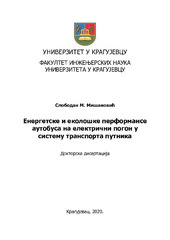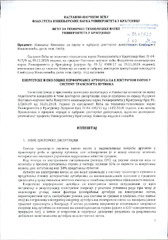Приказ основних података о дисертацији
Energetske i ekološke performanse autobusa na električni pogon u sistemu transporta putnika
Energy and environmental performance of buses on the electrical drive in the passenger transport system
| dc.contributor.advisor | Taranović, Dragan | |
| dc.contributor.other | Pešić, Radivoje | |
| dc.contributor.other | Lukić, Jovanka | |
| dc.contributor.other | Glišović, Jasna | |
| dc.contributor.other | Blagojević, Ivan A. | |
| dc.creator | Mišanović, Slobodan | |
| dc.date.accessioned | 2021-10-28T09:36:42Z | |
| dc.date.available | 2021-10-28T09:36:42Z | |
| dc.date.issued | 2021-05-28 | |
| dc.identifier.uri | http://eteze.kg.ac.rs/application/showtheses?thesesId=8298 | |
| dc.identifier.uri | https://fedorakg.kg.ac.rs/fedora/get/o:1384/bdef:Content/download | |
| dc.identifier.uri | https://nardus.mpn.gov.rs/handle/123456789/18677 | |
| dc.description.abstract | Rezime: Autobus na električni pogon (E-bus) je koncept vozila koji se sve više primenjuje u sistemu transporta putnika i predstavlja glavnu alternativu autobusima sa konvencionalnim pogonom. Energetske performanse E-busa istraživane su kroz potrošnju i rekuperaciju (regeneraciju) električne energije u realnim uslovima rada i analiziran je uticaj faktora (opterećenje, saobraćajni uslovi, rad sistema za grejanje i hlađenje, stil vožnje, itd) na vrednosti potrošene električne energije E-busa na linijama javnog gradskog transporta u Beogradu. Najmanja potrošnja električne energije E-busa je tokom prolećno-jesenjeg perioda rada, kada se ne koristi sistem za hlađenje ili grejanje vozila, pri spoljnim temperaturama između 17 i 18 sa malom i srednjom popunjenošću vozila putnicima u uslovima saobraćaja bez poremećaja na trasi. Na osnovu dobijenih rezultata istraživanja energetska efikasnost E-busa je veća 3,54 puta u odnosu na autobus sa pogonom na dizel gorivo i 4,94 puta u odnosu na autobus koji za pogon koristi komprimovani prirodni gas (KPG) u uslovima rada na liniji EKO 1 u Beogradu tokom prolećno-jesenjeg perioda rada. Ekološke performanse E-busa istraživane su kroz efekte smanjenja emisije štetnih izduvnih gasova koji nastaju povlačenjem iz upotrebe autobusa sa pogonom na dizel gorivo ili pogonom na KPG i uvođenjem E-busa umesto njih. Posmatrano na lokalnom nivou E-bus ima nultu emisiju zagađenja. U okviru ekoloških podobnosti upotrebe E-busa istraživana je emisija ugljen-dioksida (CO2) koja nastaje indirektno prilikom proizvodnje električne energije i vršeno je poređenje sa emisijama CO2 koje nastaju sagorevanjem dizel goriva i KPG kod autobusa sa konvencionalnim pogonom. Rezultati istraživanja na liniji EKO 1 dokazali su da autobusi na električni pogon posmatrano na godišnjem nivou imaju za 12,1% manju emisiju CO2 u odnosu na autobuse koji koriste dizel gorivo i za 16,4% manju emisiju CO2 u odnosu na autobuse koji koriste KPG. Istraživane su i karakteristike emitovane buke koja nastaje od Ebusa na poligonu i vršeno je poređenje sa autobusom sa pogonom na dizel gorivo i KPG u identičnim uslovima merenja. Dokazano je da autobus na električni pogon ima između 7,1% i 10,9% manji nivo emitovane buke u poređenju sa autobusom na dizel gorivo i između 2,1% i 8,6% manji nivo emitovane buke u poređenju sa autobusom na KPG. Ekonomski aspekti uvođenja E-busa obrađeni su u analizi troškova i studiji slučaja poređenja ukupnih troškova u životnom veku sa autobusima sa pogonom na dizel gorivo i KPG. Napravljen je simulacioni model rada E-busa na izabranoj liniji javnog gradskog transporta. Dobijeni rezultati srednjih vrednosti potrošnje električne energije E-busa statističkih skupova simuliranih rezultata u poređenju sa statističkim skupovima empirijskih rezultata imaju procentualna odstupanja ispod 5%. | sr |
| dc.description.abstract | Abstract: The electric bus (E-bus) is a vehicle concept that is increasingly being implemented in the public transport system and it represents a major alternative to conventionally powered buses. Energy performance of the E-buses was researched through consumption and recuperation (recovery) of electric energy in real working conditions and the influence of various factors (load, traffic conditions, operation of heating and air conditioning systems, driving style, etc.) on the values of consumed electricity of the Ebuses on urban public transport lines in Belgrade. The lowest electricity consumption of the E-bus is during the spring-autumn period of operation, when the vehicle air conditioning or heating system is not used, while the outdoor temperatures range between 17 and 18 , with low to medium passenger occupancy, and traffic conditions with no disturbances on the route. Based on the obtained research results, the energy efficiency of the E-bus is 3.54 times higher than the diesel-powered, and 4.94 times higher than the Compressed Natural Gas-powered bus (CNG-powered bus) in the conditions of work on the line EKO 1 in Belgrade, during the spring-autumn period. The environmental performance of E-buses was researched through the effects of reducing the emission of harmful exhaust gases caused by eliminating from the use of diesel-powered or CNG-powered buses and introducing E-buses. Observed locally, the Ebus has zero pollution emission. Within the ecological suitability of the use of E-buses, the emission of carbon dioxide (CO2) that occurs indirectly during electricity production was researched and a comparison was made with the emissions of CO2 caused by the combustion of diesel-fuel and CNG in buses with conventional propulsion. The results of the research on the EKO 1 line proved that electric buses, observed on an annual basis, have 12.1% lower CO2 emission, compared to buses that use diesel fuel, and 16.4% lower CO2 emission, compared to buses that use CNG. The research of characteristics of the emitted noise generated by the E-bus at the test site was also carried out, and a comparison with the diesel-powered and CNG-powered bus in identical measurement conditions. It was proven that an electric bus has between 7.1% and 10.9% lower noise emitting levels compared to a diesel-powered bus and between 2.1% and 8.6 lower noise emitting levels compared to a CNG-powered bus. The economic aspects of putting E-buses into use have been addressed through a cost analysis, and a case study comparing the total lifetime costs with diesel and CNG buses. A simulation model of Ebus operating on a selected line of urban public transport was made. The mean values of obtained results regarding the E-bus electricity consumption of the statistical sets of simulated results, in comparison with the statistical sets of empirical results, have percentage deviations below 5%. | en |
| dc.format | application/pdf | |
| dc.language | sr | |
| dc.publisher | Универзитет у Крагујевцу, Факултет инжењерских наука | sr |
| dc.relation | info:eu-repo/grantAgreement/MESTD/Technological Development (TD or TR)/35041/RS// | |
| dc.rights | openAccess | en |
| dc.rights.uri | https://creativecommons.org/licenses/by-nc-nd/4.0/ | |
| dc.source | Универзитет у Крагујевцу | sr |
| dc.subject | E-bus | sr |
| dc.subject | E-bus | en |
| dc.subject | electricity consumption | en |
| dc.subject | energy efficiency | en |
| dc.subject | recovery | en |
| dc.subject | ecology | en |
| dc.subject | CO2 emissions | en |
| dc.subject | noise emission | en |
| dc.subject | simulation | en |
| dc.subject | public transport system | en |
| dc.subject | potrošnja električne energije | sr |
| dc.subject | energetska efikasnost | sr |
| dc.subject | rekuperacija | sr |
| dc.subject | ekologija | sr |
| dc.subject | emisija CO2 | sr |
| dc.subject | emisija buke | sr |
| dc.subject | simulacija | sr |
| dc.subject | sistem transporta putnika | sr |
| dc.title | Energetske i ekološke performanse autobusa na električni pogon u sistemu transporta putnika | sr |
| dc.title.alternative | Energy and environmental performance of buses on the electrical drive in the passenger transport system | en |
| dc.type | doctoralThesis | |
| dc.rights.license | BY-NC-ND | |
| dcterms.abstract | Тарановић, Драган; Благојевић, Иван A.; Глишовић, Јасна; Пешић, Радивоје; Лукић, Јованка; Мишановић, Слободан; Енергетске и еколошке перформансе аутобуса на електрични погон у систему транспорта путника; Енергетске и еколошке перформансе аутобуса на електрични погон у систему транспорта путника; | |
| dc.identifier.fulltext | https://nardus.mpn.gov.rs/bitstream/id/77152/bitstream_77152.pdf | |
| dc.identifier.fulltext | https://nardus.mpn.gov.rs/bitstream/id/77151/Doctoral_thesis_11561.pdf | |
| dc.identifier.rcub | https://hdl.handle.net/21.15107/rcub_nardus_18677 |



